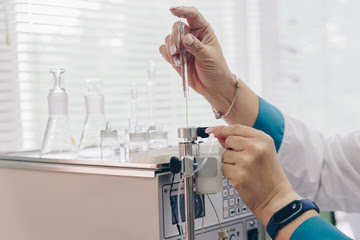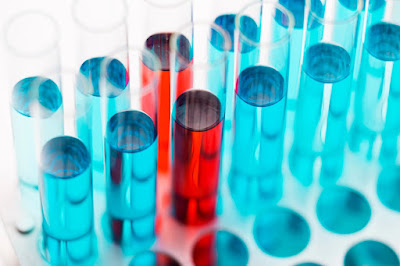What Are the Major Types of Chromatography?
Here we'll go through the types of chromatography. But I think it's a good moment to discuss what the different analytical techniques are separated based on.
So, chromatography is a
separation based on polarity differences but distillation is something where
you separate based on boiling point differences, extraction involves separation
based on acidity or basicity and spectroscopy is a way of identifying what kind
of compound do you have by looking at what type of light rays it absorbs. If
you are thinking about analytical techniques, it's good to know sort of how
they work and their general operation but also understand what they separate
based on because that can be a very commonly tested topic.
Chromatography is all separated
based on polarity differences. it separates based on a stationary phase that is
rather polar and it has an adsorbent material which is something polar that
other things bind with a mobile phase. Which is oftentimes a liquid sometimes a
gas but it contains the unknown mixture you're trying to analyze and the more
polar parts of that will interact more with your stationary phase because polar
things interact with other polar compounds.
Column Chromatography
One type of
chromatography you'll deal with is column chromatography. The stationary phase
in that is polar beads so there are beads within a packed column that has some
sort of polar quality to them. The mobile phase is a liquid mixture it's a
mixture usually with several different organic compounds contained within a
liquid that oftentimes is dissolved in ether but sometimes will be dissolved in
other things. The only real note with this is there's a vocabulary term known
as e-l-u-t-i-o-n. Elution talks about the escape from this column and how quickly
it moves through and escapes this column.
So, with column
chromatography what you do is you have a packed column with beads, and into
that, you pour a liquid mixture, and the polar components of the liquid will
attach more to the polar beads and so that means that they will travel more
slowly down the column whereas other things will travel more quickly. The least
polar compounds are the ones that don't have polarity and thus don't interact
with your stationary phase those will travel through and elute out of the
column very quickly. Whereas the more polar the component of the mixture is the
more slowly it will move because it will continuously react with that
stationary phase of those polar beads.
So, you can look at how
quickly things elute through this column when you pour your liquid in there. If
it elutes very quickly it's not polar if it elutes somewhat quickly it's not
very polar and if it takes a long time to elute and move through based on
gravity then that means that it's polar and it's interacting with your beads.
So as a result, it does not elute through the column as quickly. So that's
column chromatography and it's something you've probably encountered in an
organic chemistry lab if you've taken those courses
Paper and
Thin-Layer Chromatography
Paper and thin layer
chromatography are very similar approaches that use either a paper with an
adsorbent material where you'll have a strip of paper with some sort of polar
adsorbent material incorporated into the paper or with the thin layer you have
either a sheet of glass or plastic that is similarly in a strip and on that
glass or plastic you've attached some sort of polar adsorbent material as your
stationary phase. So, both of these look very similar.
What you do with these
is you'll mix up your compound/ unknown mixture and you'll place little dots on
a distinct point perhaps you'll make a line on the paper or the thin layer
material. You'll put little dots here and then what you'll do is you'll end up
placing this in perhaps some sort of beaker or something containing a solvent
which will usually be an ether. When you see an ether, there are one or two
reactions that it can participate in, however, when you see an ether your first
thought should be that ether is a solvent. So, this is the way chromatography
works, you take this strip with your little dots where you've dabbed your
sample on there and you put it into a beaker containing a solvent like an
ether.
What will happen is as
you know for example with paper the ether will attach to the paper and then it
will continue to travel or migrate up. The paper and the ether being a fairly
non-polar group will travel quite quickly because the ether is not going to
interact very much with the adsorbent material. Which is either on the surface
of your thin layer or it's incorporated into your paper. The way that this
works are the ether or the solvent will continue to rise and it will rise
slowly. Eventually, it will reach the level where you've created those little
dots where you've dabbed the material onto your stationary phase. This material
will get caught up in the ether solvent and so it will continue to travel
upwards as well. It will be your solvent as well as your sample migrating up.
This stationary material and the way that it separates is very similar to the
chromatography of other types like column chromatography.
Essentially the more
polar components of these mixtures will travel more slowly and so they will not
move as quickly as the ether moves up your sample. You might run this procedure
for 5 minutes or 20 minutes or some given amount of time. But essentially what
will happen is the ether will just continue to migrate up until it reaches some
level that you've established perhaps you've drawn a line on this paper or your
thin layer material.
The very polar
components will migrate very little because they will have been too busy
interacting with the adsorbent material. They will have moved a small amount
the less polar components of your mixture will move more quickly. This one
notice has moved a fair bit it's more polar than an ether because the ether
moved up. But it's far less polar than something that didn't move very
much. So, the rule is “the less it travels the more polar that compound is”.
There might be various ways that you can then visualize the separation you
might use iodine or something like that. But you're not responsible for knowing
that procedure on the MCAT.
But what you are
responsible for knowing is that the more polar components when they're caught
up with the ether they will not migrate as quickly as the ether solvent. So,
the things that travel less are going to be more polar and the things that
travel more are going to be less polar. And again, it's because the polar
things interact with your adsorbent material and the non-polar things don't.
When you're dealing with
either of these two types of chromatography and remember that the mobile phase
is your liquid mixture carried in your solvent. When you're dealing with either
paper or thin-layer chromatography you'll hear the term RF or retardation factor fairly often. It's the amount that the movement is that it's slowed down
by the fact that the material is interacting with your adsorbent material. So, if
it's a more polar component of your mixture it will interact a lot more and
that will slow or retard its movement up this stationary phase.
How To Calculate
Retardation Factor (RF)?
The way that you calculate
an RF is fairly simple you look at the distance that the substance
migrates. You can simply compare the distance migrated by your substance versus
the distance migrated by your solvent front and then you're going to be able to
calculate the retardation factor for that component. Which is the distance traveled
by your substance over the distance traveled by your solvent front.
So, you measure from the
line, where the solvent was moving up, and finally interacted with those dots
that you placed on the paper. Then you look at the distance that it migrated,
you essentially look from that line to the point where you're seeing the dot
visualized, and then you compare that to the distance migrated by solvent
front. The solvent front is just how quickly the solvent “ether” is moving up
and we have an assumption that because the ether is not a very polar compound
it will travel more quickly. So, the solvent front will reach all the way and
you'll see a level of dampness moving up and up and up until it reaches a
defined point
Gas-Liquid
Chromatography
It's very similar to
column chromatography in a lot of ways but there is one difference. In the
column, your stationary phase was solid beads that are very polar while in
gas-liquid chromatography the stationary phase is liquid. That is somehow
attached to a packed column and so you have a column with a liquid attached to
it. The mobile phase in this case rather than being a liquid, like it was in
column chromatography, the mobile phase here is a gas that is mixed with some
sort of carrier gas. Something that is inert and won't interact but can help
carry your compound. That will usually be something like helium.
So, what you do is you have
your mixture of the sample and you inject it with a carrier gas like helium.
Then it goes travels and interacts with the column which contains your liquid.
Certain components of this gas and carrier mixture will interact with the
column more usually based on their polarity. Once that interacts with the
liquid stationary phase a lot of those will elute more slowly. We used the word
elution with column chromatography we also use elution with gas-liquid
chromatography.
The difference is that
our mobile phase is now our sample mixture injected with a carrier gas so now it
exists in a gas phase and it travels through here it will interact with our
column containing the liquid some parts will interact with the liquid a lot of
other parts won't interact with the liquid very much and the ones that interact
less usually meaning they're less polar or somehow, they don't want to interact
with that liquid stationary phase. The ones that interact with the liquid less
will elute more quickly and they'll reach our detector first and then the
components that are perhaps more polar or somehow interact more with our
stationary phase those will elute more slowly.
So once again we're
finding a way to separate our mixture but this time it's by injecting it with a
carrier gas and using a gas mobile phase and a liquid stationary phase. But with
all of these if you can realize that the stationary phase is going to be
something that is polar and that the mobile phase will either be a liquid or
gas that interacts with that stationary phase. It becomes clear that we can
separate these things based on polarity differences.
The more polar
components of your mobile phase which is usually your unknown liquid. The more
polar components of that mobile phase will travel more slowly. Whether it
involves eluding through a column whether it involves migrating up a thin layer
or paper compared to the rate at which the solvent does that or whether it
involves moving through a column when injected with a carrier gas. The more
polar components will travel less and so that allows us to separate a lot of
our unknown compounds based upon the differences in the polarity of its
different components that are chromatography it's a separation that takes
many different shapes but it's always going to be separating based upon
polarity differences








Comments
Post a Comment